9 DOCUMENT CONTROL
AIC-B 04/2021 (16 DEC 2021) is hereby cancelled.
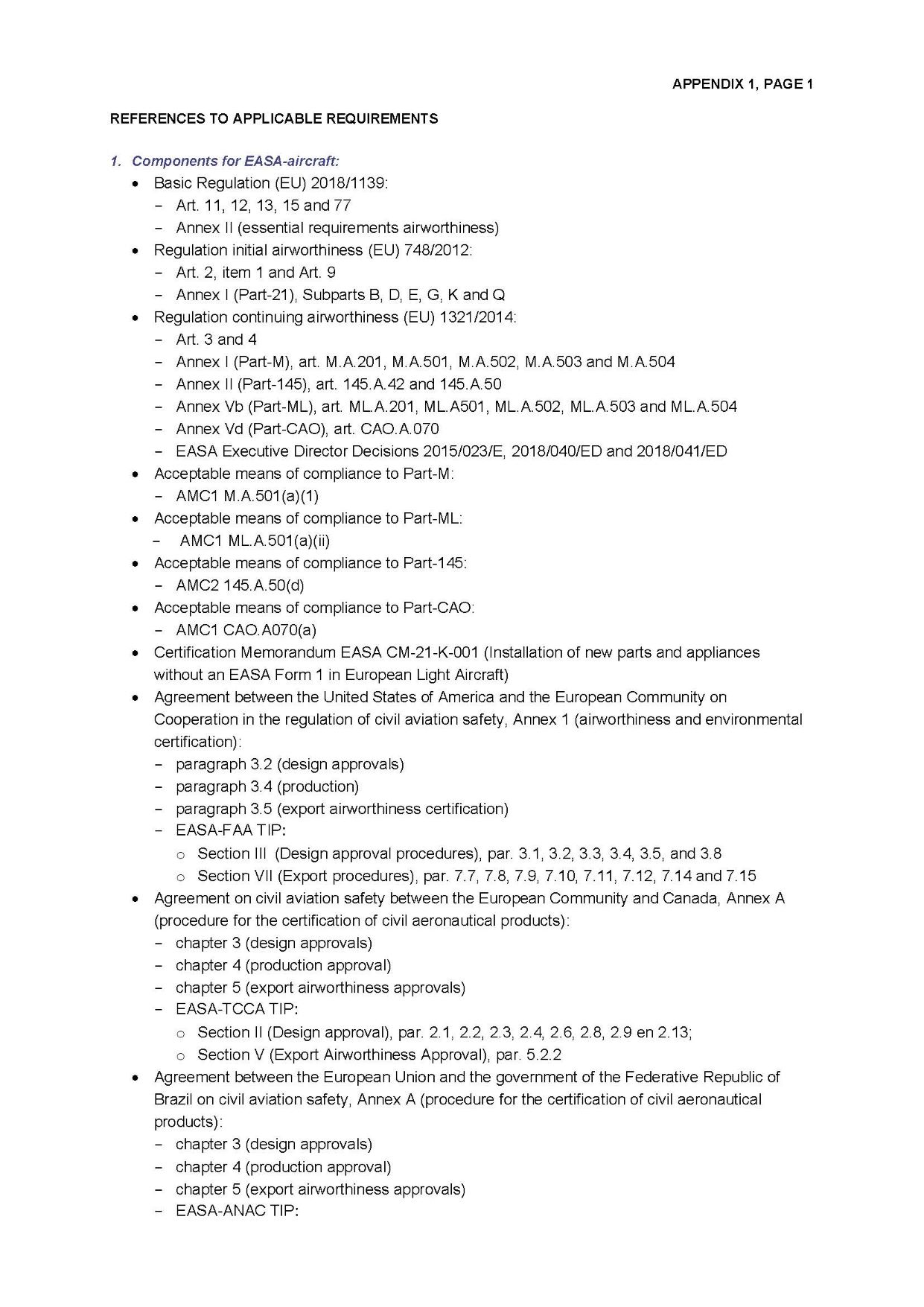 |
|---|
 |
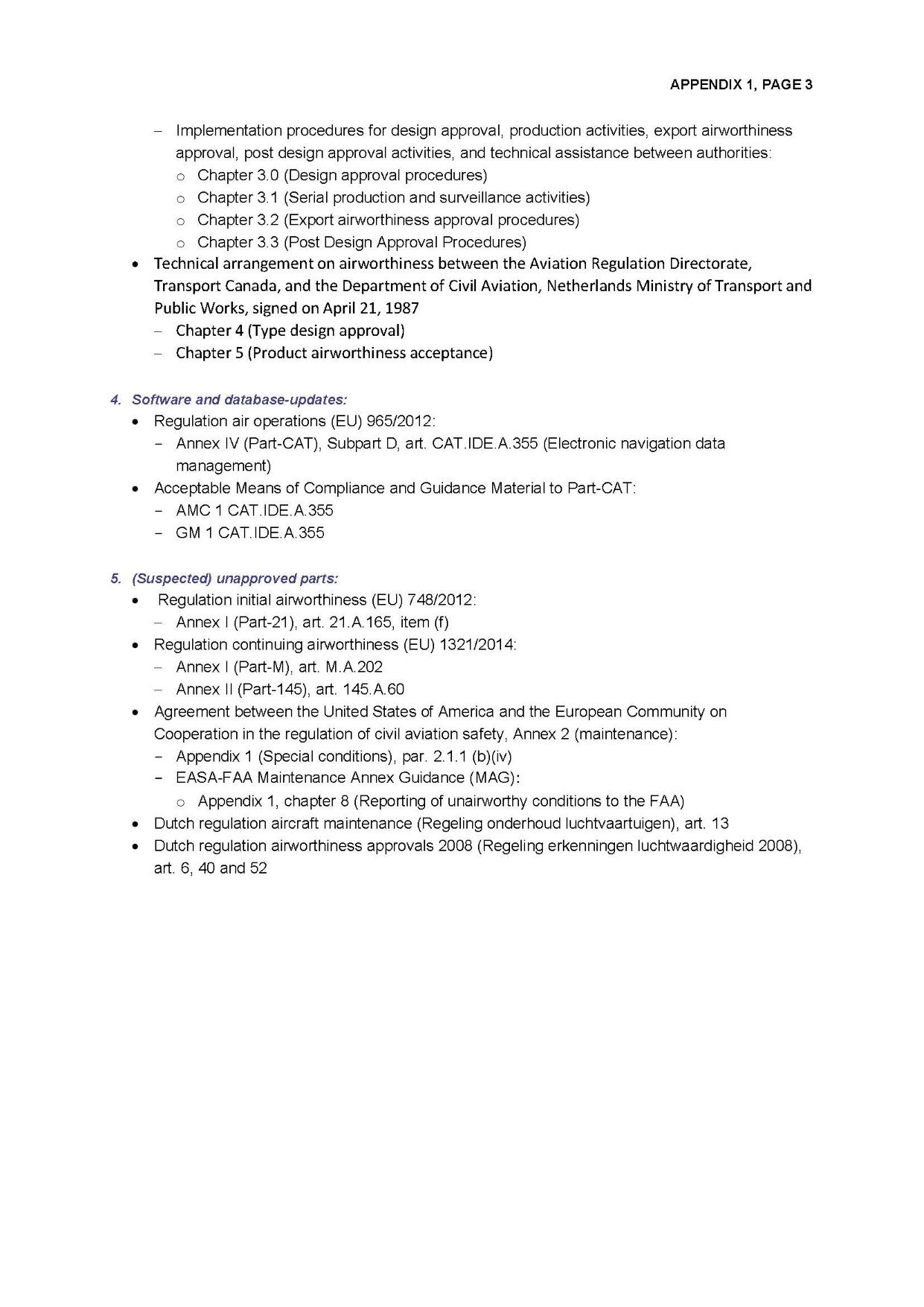 |
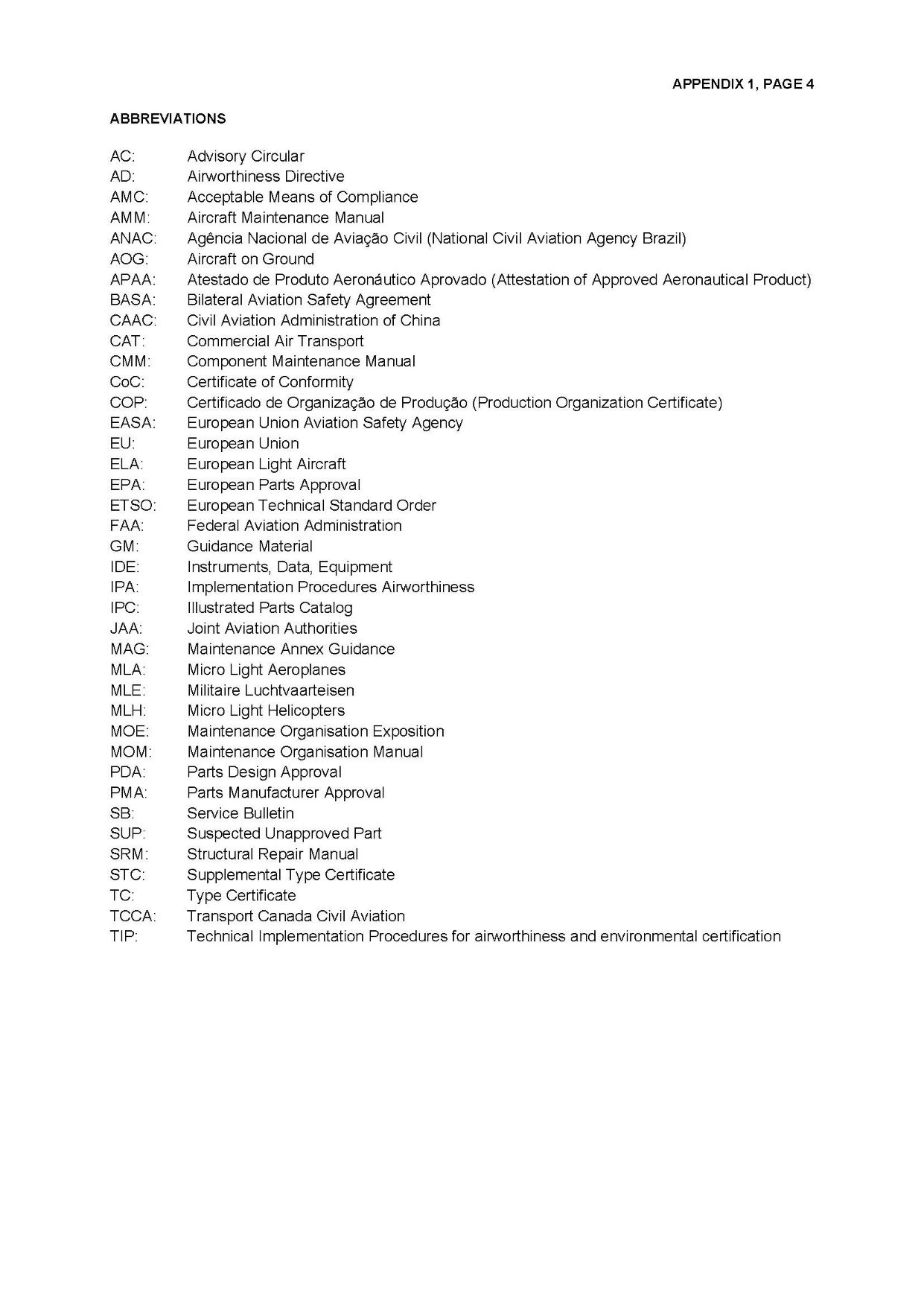 |
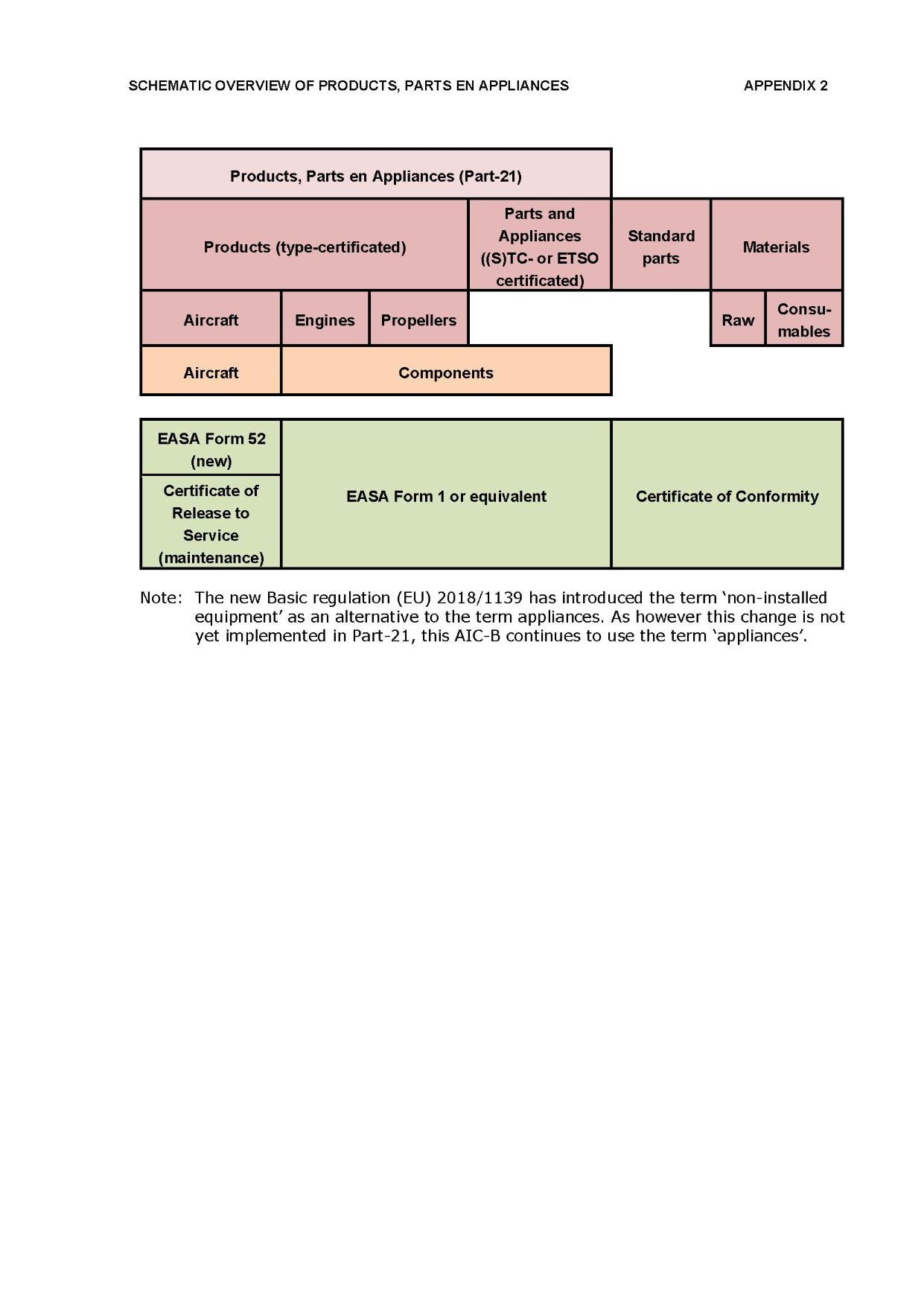 |
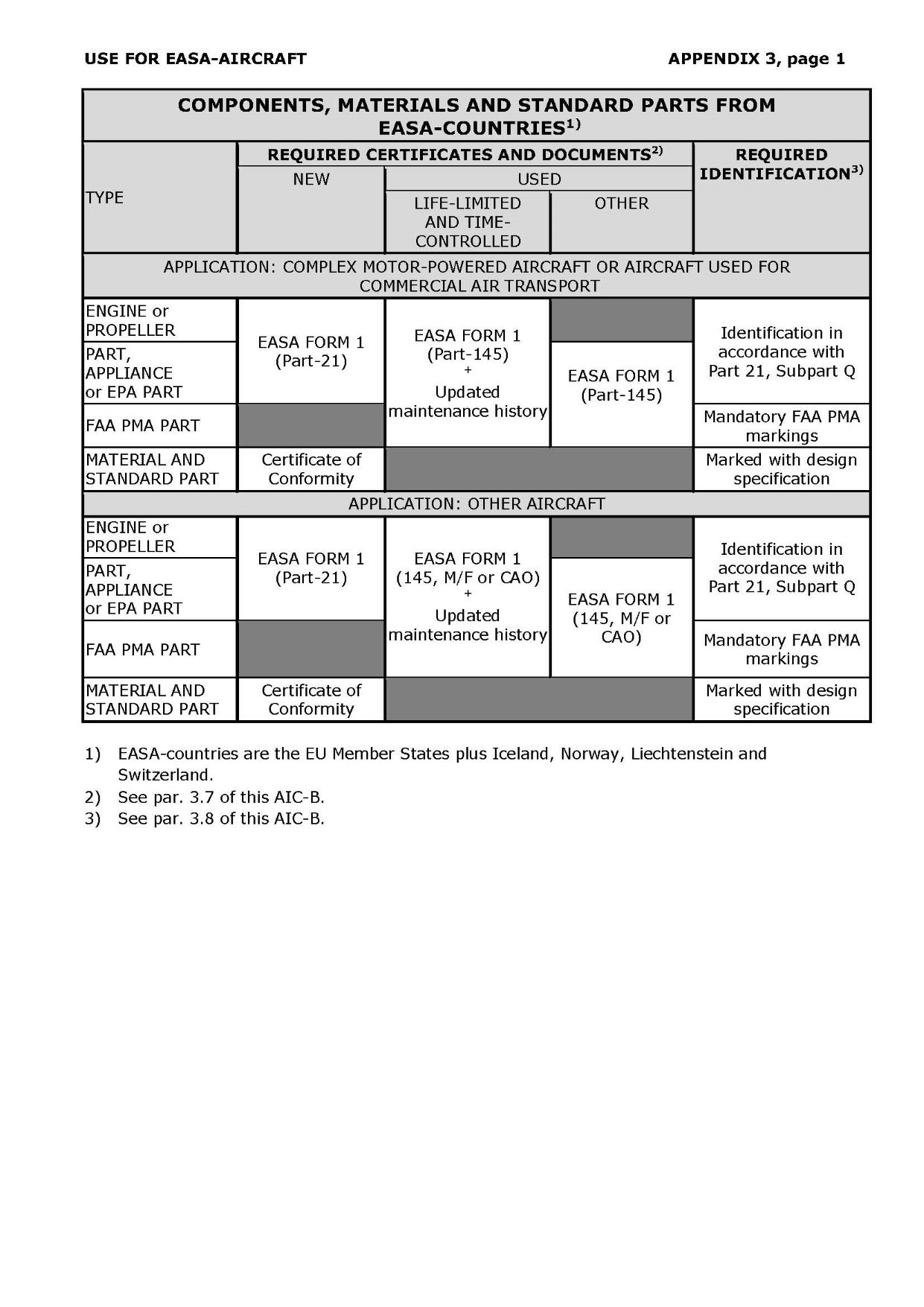 |
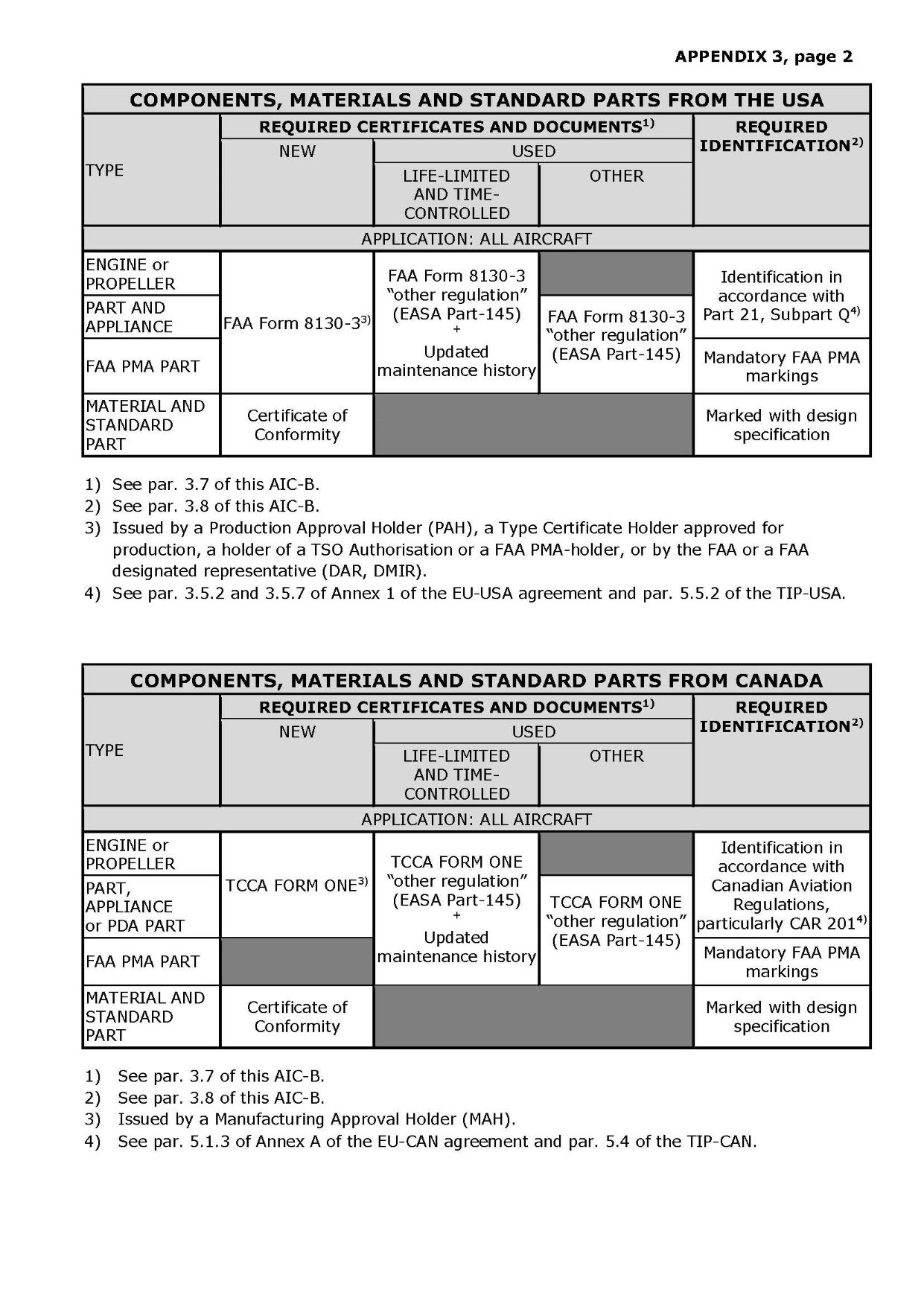 |
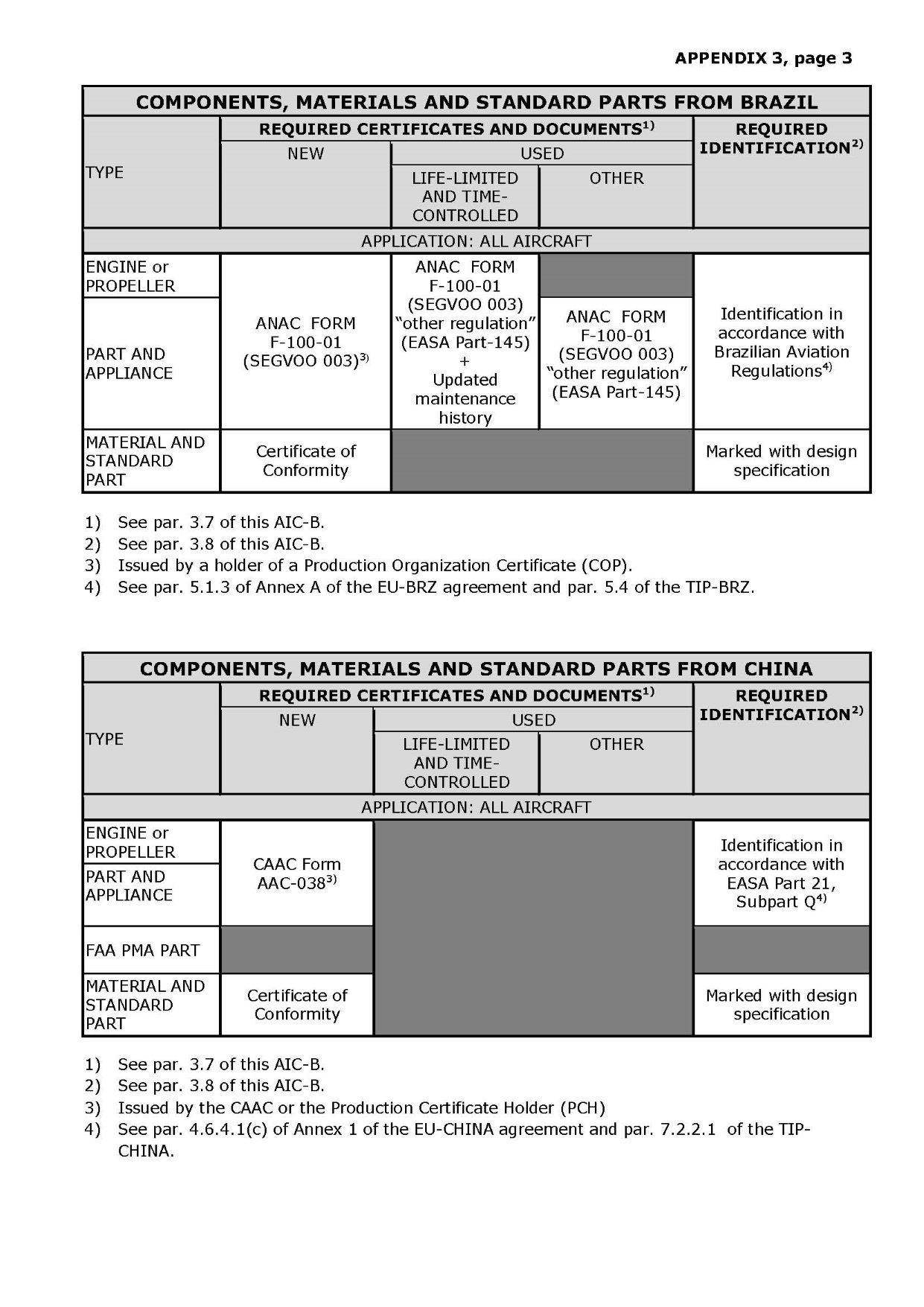 |
 |
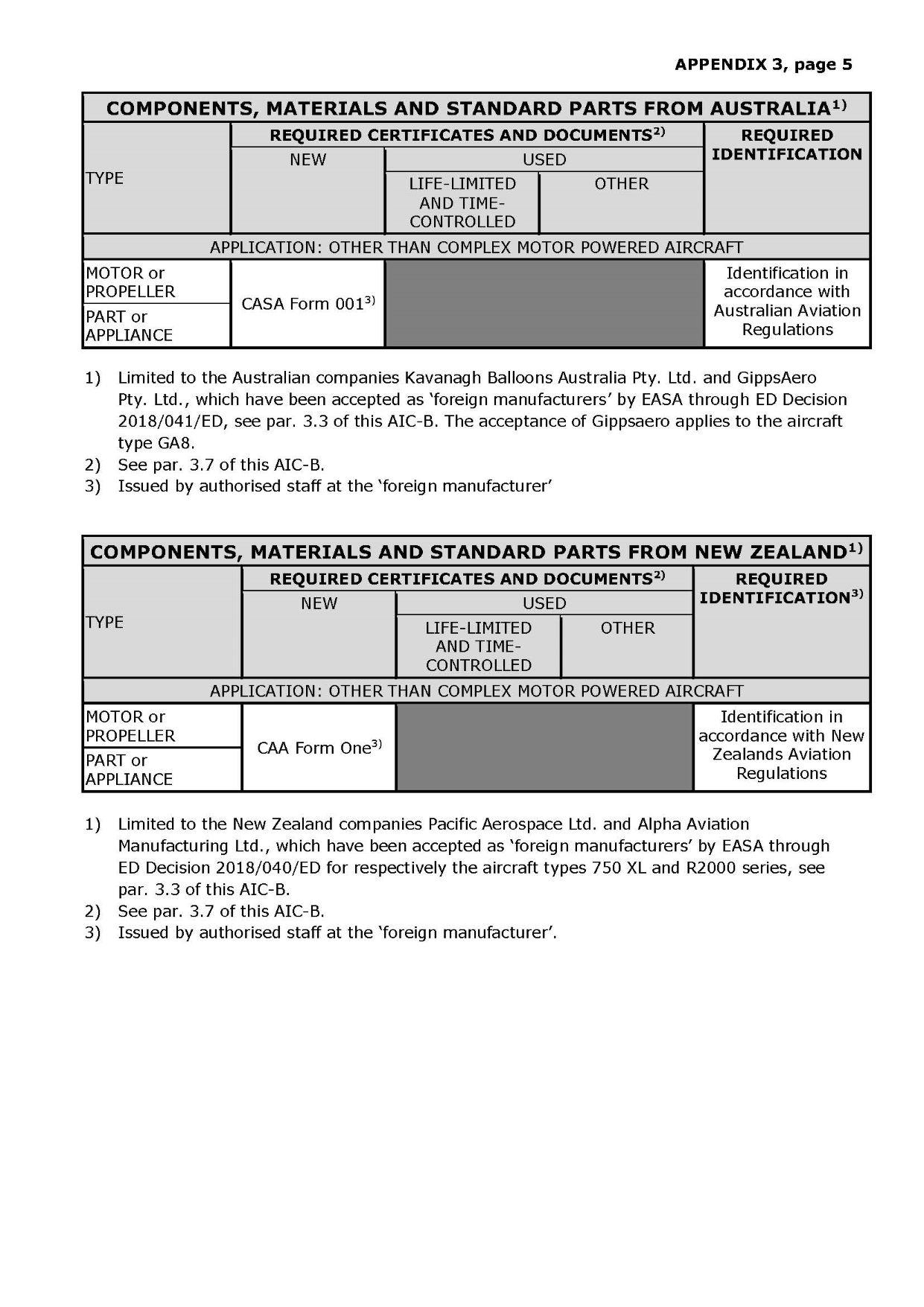 |
Contact
| Aeronautical Information Circular | AIC-B_en 01/2023 Publication date 29 JUN 2023 |
In this AIC-B the CAA-NL refers to applicable requirements for the acceptance of aircraft components, materials and standard parts. Details of the references can be found in Appendix 1 to this AIC-B. This appendix also includes a list of abbreviations.
This AIC-B is of interest to everybody who is dealing with (purchasing, inspecting, maintaining, installing, etc.) aircraft components, materials and standard parts, intended for use in aircraft registered in the Netherlands, differentiated in:
To all aircraft the rule applies that the use of each individual element, fitted on an aircraft shall be in compliance with the approved design of that aircraft. In accordance with European terminology (also useful for aircraft to which national regulations apply) elements are distinguished in:
Components are made specifically for aviation purposes. The design has been approved in accordance with the applicable airworthiness requirements and each individual component has to be produced in accordance with the design specifications of that approved design, to be confirmed by an accompanying release certificate.
In 2018 the amended European Basic regulation introduced the term 'non-installed equipment' as an alternative for appliances. As this new term is however not yet adopted in the implementing rules, this AIC-B continues to use the term 'appliances'.
The use of standard parts and materials is not limited to aviation. They comply with generally established industry- or government specifications.
In deviation to the differentiation into components and standard parts, additionally also equipment exists that cannot be classified in one of these categories, because of exemptions from the airworthiness requirements in accordance with Air operations regulation (EU) 965/2012.The items which are exempted are specified in the IDE.100 sections in the various annexes of the regulation. The exemption is only valid insofar the applicable items are not an element of the approved design of an aircraft. When those items are however included in the Illustrated Parts Catalog (IPC) or equivalent document for that aircraft, the items are perceived as parts and then the airworthiness requirements do apply.
The structure of products, parts and appliances is schematically pictured in Appendix 2.
| Subject | Source |
|---|---|
| Basic regulation (EU) 2018/1139, art. 3 |
| Basic regulation (EU) 2018/1139, art. 140 |
| Regulation initial airworthiness (EU) 748/2012, art. 1 |
| Component | Regulation continuing airworthiness (EU) 1321/2014, art. 2 |
| Standard parts |
|
| Materials (raw and consumables) | AMC M.A.501(a)(5), items (a) and (b) |
Almost all components need a European design approval. This approval needs to be issued through certification in accordance with EASA Part-21 requirements or through validation under the terms of a bilateral agreement signed by the European Community (BASA)1). In these agreements the principle of 'reciprocal acceptance' applies. The principle of ‘mutual recognition’ does not apply. It means that the parties of the agreement continue to issue their own approvals on the basis of the approval issued by the other party. Depending on the partner country there may be exceptions to this principle, particularly for minor modifications, designs of non-critical replacement parts and repair designs. In those cases a design approval from one party is often automatically valid for the other party. The specific details can be found in the applicable Technical Implementation Procedures (TIP).
Engines and propellers shall have a type-certificate. The design approval for parts and appliances can be obtained in several ways, being:
Identification specifications of EASA approved minor and major changes to a type-certificate, applied for by others than the holder of the type-certificate (c. and d.), shall contain the letters EPA (European Parts Approval) (ref. 21.A.109 and 21.A.118).
Current TC's, STC's and ETSO authorisations can be found on the EASA website. The airworthiness of each approved design has to be maintained by the holder of the approved design (design approval holder).
The use of new components is permitted when they are produced in compliance with the drawings and design specifications of the approved design by:
The use of used components is permitted when they are maintained in accordance with the continued airworthiness instructions1) applicable to the approved design and with EASA Part-M or Part-ML requirements by:
It is also permitted to use components maintained by an aircraft manufacturer appropriately approved in accordance with EASA Part-21 Subpart M/G, provided the maintenance was performed for continuing airworthiness reasons of the new aircraft, in which the components were installed (ref. AMC 21.A.163(d)). The components remain classified as new.
Provided it is to be applied for a European approved design, the use of:
Use of EPA-parts is always permitted, when properly identified and only for the intended use as part of the approved modification for which it is designed.
Standard parts and materials may be used in accordance with EASA Part-M requirements. Application is permitted in accordance with instructions, appertained to the approved design of an aircraft or a component (commonly the IPC) (ref. M.A.501(a)(4) and M.A.501(a) (5)).
In order to demonstrate that a component has been produced or maintained in accordance with the approved design, it needs to be provided with the required release certificate, issued by an entity that has the applicable privilege. For EASA aircraft this is the Authorised Release Certificate (EASA Form 1) or an equivalent release certificate under the terms of a bilateral agreement signed by the European Community, particularly the FAA Form 8130-3, the TCCA Form One1), the ANAC Form F-100-012), the CAAC Form AAC-038, the JCAB Form 18 and the CAA Form 1. The EASA Form 1 shall contain the information as indicated in Appendix I of EASA Part-21 for new components and in Appendix II of EASA Part-M for used components. The certificate needs to refer to the approval of the organisation being responsible for the production or the maintenance of the component. The equivalent foreign release certificates shall contain the same information. In the case of used parts these certificates shall additionally contain in Block 123) a statement that the maintenance has been performed in accordance with applicable European regulations by an EASA Part-145 approved maintenance organisation with reference to the EASA approval number. Generally a dual release applies, where in Block 14a always the box "other regulation" shall be ticked (ref. MAG-USA, Section B, Appendix 1, item 10 and MAG-CAN, Section B, Appendix 2, item 9). The Chinese Form AAC-038, the Japanese JCAB Form 18 and the UK CAA Form 1 only apply to new components.
Except for the aforementioned foreign release certificates, also the formerly used JAA Form One is equivalent to the EASA Form 1 in accordance with AMC M.A.501 501(a)(1), items (a)(3), (a)(5) or (a)(6) or AMC1 ML.A.501(a)(ii), items (c), (e) or (f)), provided not being issued later than:
For used components that are service- or life limited the EASA Form 1 or equivalent certificate shall be accompanied by an updated maintenance status with reference thereto in Block 121) of the certificate. Except for configuration data (modifications, repairs, ADs and SBs) the status shall contain information on the utilisation, particularly accumulated service life in relation to life limits (ref. Appendix II of EASA Part-M, item 5).
In accordance with EASA Part-21 certain parts and appliances do not need to be accompanied by an EASA Form 1 (ref. 21.A.307(b)). Except equipment exempted from the airworthiness requirements in accordance with Regulation (EU) 965/2012, it concerns certain parts for installation in ELA1- and ELA2-aircraft and parts and appliances, having a negligible safety effect on a type-certified product when installed in that product, whilst deviating from the approved design data and identified as such by the design approval holder of the product concerned.
Standard parts and materials have to be delivered with a Certificate of Conformity (CoC) or an equivalent document, as evidence that they have been produced in accordance with the applicable design specifications, that the document shall clearly refer to. The document shall also contain details about the origin (manufacturer, supplier and if present, batchnumber) and if relevant, information on storing conditions, shelf lives and life limitations (ref. AMC1 M.A.501(a)(4)) en AMC M.A.501(a)(5).
A CoC or equivalent document is also necessary for parts and appliances exempted from the EASA Form 1 obligation (ref. 21.A.307(c)).
Used parts and appliances, exempted from the EASA Form 1 obligation and not intended for installation in ELA1- or ELA2-aircraft, need to be accompanied by a declaration of maintenance accomplished, issued by the person of or organisation that performed the maintenance activities. Maintenance of exempted parts and appliances to be installed in ELA1- and ELA2-aircraft is subject to aircraft release requirements and does therefore not result in such an accompanying declaration.
In certain conditions components, not being accompanied by an Authorised Release Certificate, may be issued with an EASA Form 1 by an appropriately rated maintenance organisation in accordance with EASA Part-CAO or EASA-Part 145 (ref. CAO.A.070, AMC1 CAO.A.070(a), 145.A.50(d) and AMC2 145.A.50(d)).
If an aircraft is in an AOG situation due to the non-availability of a component with the appropriate release certificate, it is allowed to temporarily install a component without the appropriate document, but with an alternative suitable release document, in accordance with conditions specified in EASA Part-145 (ref. 145.A50(f)). A CoC is not a suitable alternative.
Each component shall be marked in accordance with EASA Part-21 Subpart Q or in accordance with the terms of bilateral agreements signed by the European Community. FAA-PMA parts shall be provided with the following markings:
An EPA marking is not required for FAA-PMA parts, neither for replacement parts from other countries with a bilateral agreement signed by the European Community.
As of March 5, 2019 EASA Part-145 approved maintenance organisations explicitly need to have procedures for the acceptance and installation of components, standard parts and materials, also in order to adequately classify components as serviceable, unserviceable or unsalvageable (ref. 145.A.42(b).
The use of components in aircraft to which national regulations apply, is permitted when that use is in accordance with the requirements applicable to EASA aircraft or alternatively in accordance with national requirements. These national requirements are addressed here.
Alternative requirements for a European design approval are:
The use of new components is alternatively permitted when they are produced by an organisation approved in accordance with applicable Netherlands law (Besluit luchtvaartuigen 2008, chapter 6), by an organisation acceptable to the Netherlands law or by an approved organisation in the USA or Canada in accordance with respectively the bilateral agreement or technical arrangement of the government of the Kingdom of the Netherlands with these countries. Nationally approved organisations in EASA-countries are acceptable to the Netherlands law.
The use of used parts is alternatively permitted when they are maintained by an organisation approved in accordance with applicable Netherlands or equivalent foreign law or by an organisation acceptable to the Netherlands law. Equivalent foreign maintenance organisations approvals are limited to national approvals in EASA-countries, USA, Canada and UK. For those components applies that apart from an EASA Form 1, or a Netherlands release certificate, they may be delivered with a:
Components not designed in accordance with internationally recognized standards, may also be delivered with a Certificate of Conformity (CoC), provided it is demonstrated to what standard the design is approved. This particularly applies to components installed in historical military aircraft or MLA's.
Also for use in nationally regulated aircraft, standard parts and materials may be used in accordance with EASA Part-M requirements. Application is permitted in accordance with instructions, appertained to the approved design of an aircraft or a component (commonly the IPC).
As evidence that a component has been produced or maintained in accordance with the approved design, the same requirements apply as for EASA aircraft. An EASA Form 1 is permissible as the Netherlands release certificate. In that case, used components being maintained in accordance with national regulations, shall be released with only the box "other regulation" in Block 14a ticked, with a reference to the applicable requirements in Block 12.
Software applied in aircraft is defined as parts and appliances. Therefore its use is only permitted in accordance with the approved design. This applies to all operational software installed in airborne equipment. Revisions to the software may only be installed in accordance with the applicable maintenance instructions. The software and its revisions need also to be accompanied by the required release certificates for parts and appliances.
Navigation databases are not defined as software. Therefore database-updates for navigation purposes do not need to be accompanied with the required release certificates for parts and appliances. For EASA aircraft the updates may be performed in accordance with Agency Opinion 01/2005. For aircraft, used for commercial air transport, subpart D of Part-CAT applies.
To prevent the use of unapproved parts and SUPs, approved maintenance organisations are advised to include the ideas of FAA AC 21-29C in their MOE and to check the EASA Safety Information Bulletins weekly.
Discovery of unapproved parts and SUPs needs to be reported in accordance with Part-21, Part-M, Part-145 or local Netherlands requirements, whatever apply. Organisations may use their own reporting tools, except in cases when regulations require a certain format. Important details for reporting are:
Maintenance organisations, also approved in accordance with 14 CFR part 145 as a FAA Repair Station, shall also inform the FAA in accordance with the MAG-USA. To this purpose these organisations shall have a procedure in the FAA supplement of their MOE.
Components that are not meeting the design specifications anymore and cannot be brought into conformity with such specifications shall be excluded from re-use and mutilated in accordance with EASA Part-M or EASA-Part-ML (ref. M.A.504 and ML.A.504).
This AIC-B is issued to update AIC-B 04/2021 (16 DEC 2021) due to the introduction of the declaration of maintenance accomplished regarding the installation of used parts and appliances without an EASA Form 1 and due to some editorial changes in the applicable legislation.
Further information about this AIC-B may be obtained at CAA-NL. Contact details can be found on the website.
| URL: | https://www.ilent.nl |
| Tel: | +31 (0)88 489 0000 |
AIC-B 04/2021 (16 DEC 2021) is hereby cancelled.
 |
|---|
 |
 |
 |
 |
 |
 |
 |
 |
 |